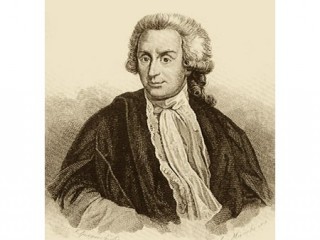
Luigi Galvani biography
Date of birth : 1737-09-09
Date of death : 1798-12-04
Birthplace : Bologna, Italy
Nationality : Italian
Category : Historian personalities
Last modified : 2011-10-18
Credited as : physiologist, animal electricity,
The Italian physiologist Luigi Galvani is noted for his discovery of animal electricity.
Luigi Galvani was born at Bologna on Sept. 9, 1737. He studied theology for a while and then medicine at the University of Bologna. In 1762, upon completion of his studies, he was appointed lecturer of anatomy and surgery at Bologna. His interest focused on the animal senses, which led him into deep theoretical interest in the action of the nervous system.
By the middle of the 18th century various books on electricity were available in Italian, and in 1744 Benjamin Franklin's famous book on electricity appeared in Italian translation. Galvani was influenced by Franklin's "one fluid theory," according to which electrical phenomena were caused by an electric fluid that results in so-called positive electricity, while so-called negative electricity was the absence of fluid. What seemed especially important to Galvani was Franklin's explanation of the Leyden jar, the early form of condenser. According to Franklin, positive electricity accumulated on the inner conductor while the outer conductor became negatively charged. The whole setup was similar to an accumulation of fluid on the inside of the bottle. Galvani drew an analogy between the Leyden jar and animal muscle and carried out his experiments with this thought in mind. He studied the effects of electricity from lightning on muscular contractions in a frog and proved that the electricity produced muscular convulsions.
Galvani's first announcement of his experiments appeared in a paper, "On the Effect of Electricity on Muscular Motion," published in 1791. He also gave an account of convulsions produced in a frog, in the absence of an electrical machine, when the frog formed part of a circuit containing one or more pieces of metal. Galvani had observed motion of the nerve juices during these convulsions and proposed the theory that the convulsions were caused by electricity within the animal's body; the muscle fiber and the nerve were acting like a Leyden jar.
Galvani's great Italian contemporary Alessandro Volta began working on animal electricity in 1792 and came out in direct opposition to Galvani's theory of an animal electrical fluid. It was then that the famous controversy between the two began. Volta proved that the nerves were nothing but electrical conductors and that it was possible to get electrical effects by placing any two metals in contact with an intervening piece of moistened cardboard. In this controversy Volta was correct in his physical interpretations, yet it was Galvani's influence which fostered the flourishing science of neurophysiology in the 19th century. However, the controversy between the two men spread into their personal relations and even into Italian politics of the time.
After the Cisalpine Republic was established in 1797, Galvani refused to swear allegiance to it on religious grounds and was dismissed from his university position. Volta swore allegiance and played a central role in the republic. Galvani was reinstated a year later, but by then he was a completely broken man. He died on Dec. 4, 1798.
















